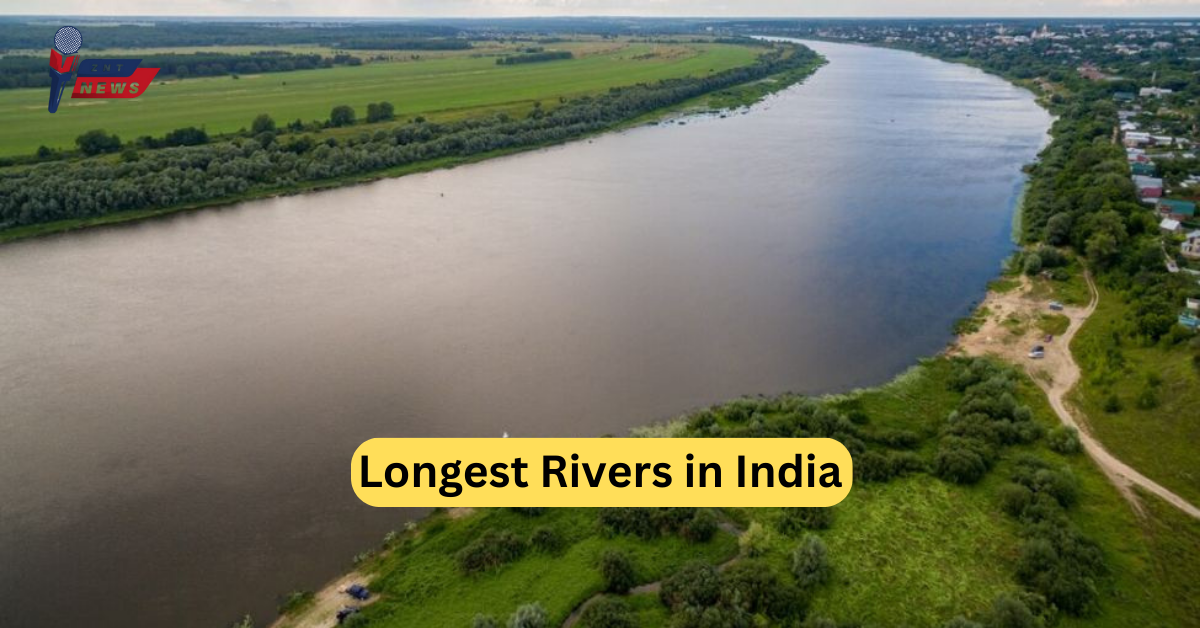Top 10 Longest Rivers in India
Top 10 Longest Rivers in India: India, often hailed as the land of rivers, boasts an extensive network of water bodies that significantly contribute to the country’s economic development. Divided into two categories – Himalayan Rivers originating from the Himalayas and Peninsular Rivers originating in the Peninsula – these majestic rivers paint a diverse and vibrant picture. In this article, we delve into the top 10 longest rivers in India, unraveling their origins, courses, and the crucial role they play in shaping the landscape.
List of Top 10 Longest Rivers in India

The Ganges River – 2525 km
The Ganges, or Ganga in India, holds unparalleled significance in Hindu beliefs and stands as the longest river on the Indian subcontinent. Originating from the Gangotri Glacier in Uttarakhand, it begins its journey at the confluence of Bhagirathi and Alaknanda rivers in Devprayag. Flowing through Uttarakhand, Uttar Pradesh, Bihar, and West Bengal, the Ganges concludes its majestic course in Bangladesh, merging into the Bay of Bengal. Despite its sacred status, the Ganges faces contamination issues, affecting both humans and diverse wildlife along its banks.
Godavari River – 1464 km
Second on the list, the Godavari, also known as Dakshin Ganga or South Ganges, covers an impressive length within India. Originating from Triambakeshwar, Nasik in Maharashtra, it meanders through Chhattisgarh, Telangana, and Andhra Pradesh before gracefully meeting the Bay of Bengal. The river serves as a sacred site for Hindus, with Nashik, Nanded, and Rajahmundry being prominent cities along its banks.
Krishna River – 1400 km
Emerging from Mahabaleshwar, the Krishna River holds the title of the third-longest river in India. It traverses through Maharashtra, Karnataka, Telangana, and Andhra Pradesh, offering a vital source of irrigation for these states. The river eventually finds its way to the Bay of Bengal, with prominent tributaries such as Bhima, Panchganga, and Tungabhadra enhancing its flow. Sangli and Vijayawada stand as key cities along the Krishna’s course.
Yamuna River – 1376 km
The Yamuna, originating from the Yamunotri glacier in Uttarakhand, is the longest tributary of the Ganges. While not directly reaching the sea, it weaves through Uttarakhand, Himachal Pradesh, Delhi, Haryana, and Uttar Pradesh. The Yamuna boasts significant tributaries like Hindon, Sharda, and Chambal, contributing to its extensive network.
Narmada River – 1312 km
Revered as the “Life Line of Madhya Pradesh and Gujarat,” the Narmada River flows westward from its origin in Amarkantak. Unlike other rivers in India, the Narmada holds a special place as one of the seven heavenly rivers according to Hindu beliefs. Its contribution to Madhya Pradesh and Gujarat is immense, with the river considered holy by the local population.
Indus River – 3180 km
The Indus River, originating from Mansarovar Lake, is steeped in history as it played host to the flourishing Indus Valley Civilization. While its total length spans 3180 kilometers, only 1,114 kilometers fall within Indian territory. Jansker, Chenab, and Sutlej are among its crucial tributaries, with Leh and Skardu standing as major cities along its course.
Brahmaputra River – 2900 km
Originating from the Angsi Glacier near Mansarovar Lake, the Brahmaputra enters India through Arunachal Pradesh. It then flows through Assam, forming the lifeblood of the Kaziranga National Park. The Brahmaputra continues its journey into Bangladesh, with its total length within India measuring 916 kilometers.
Mahanadi River – 890 km
The Mahanadi River begins its journey in the Raipur district of Chhattisgarh. Known for its historical floods, the construction of the Hirakud Dam has mitigated the impact, ensuring better control over the river’s flow. Tributaries such as Seonath and Jonk contribute to the Mahanadi’s significance in the region.
Kaveri River – 800 km
The Kaveri River, rising in Brahmagiri Hill of the Western Ghats in Karnataka, traverses through Karnataka and Tamil Nadu. Celebrated for its scenic beauty, the Kaveri holds immense sanctity in Tamil literature. The river’s course is marked by numerous distributaries, forming a wide delta known as the “garden of southern India.”
Tapti River – 724 km
Originating in the Betul district of the Satpura Range, the Tapti River is one of the three rivers in Peninsular India flowing from east to west. Passing through Madhya Pradesh, Maharashtra, and Gujarat, it drains into the Gulf of Khambhat. The Tapti River, with tributaries like Purna and Girna, completes the list of the top 10 longest rivers in India.
Conclusion:
Top 10 Longest Rivers in India: These rivers not only contribute significantly to the geographical diversity of India but also play a vital role in the cultural, economic, and ecological aspects of the nation. The extensive network of these water bodies showcases the richness and resilience of India’s riverine heritage.
………………….By ZNT News
